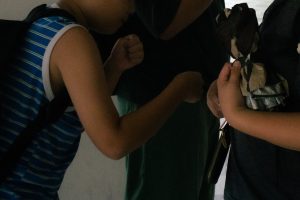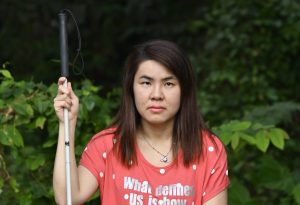All image credits: Danon Gabriel The
No one seems to enjoy rejection more than Gyan Lee. But it wasn’t always this easy. He tells us, “It’s very interesting how a lot of times, because I’ve been rejected, it becomes an entirely new routine. But the people who rejected me now find this part funny.”
“It’s all about improvising,” he says. Next to him, Cynthia Lee MacQuarrie, his colleague and show business veteran, nods her head in agreement.
As they talk about their backgrounds and how they both became involved with Clown Doctors Singapore via a casting call back in 2014, it’s easy to think that the work they do as medical clowns is all about entertainment. Because of certain similarities to party clowns, they are often mistaken as performers whose work revolves around cheering people up.
But this couldn’t be further from the truth. Both Cynthia and Gyan make it very clear that they don’t entertain patients, and their costumes are a testament to this. They dress only in a lab coat and a red nose. There isn’t any of the face paint or exaggerated outfits we normally associate with clowns. If not for their red noses, they could pass for healthcare professionals if one wasn’t paying too much attention.
In fact, one could say that what they do is a kind of allied health.
“There are occupational therapists and physiotherapists, and we kind of fall into that as well,” Cynthia says. “The only difference is that we’re using humour as therapy.”
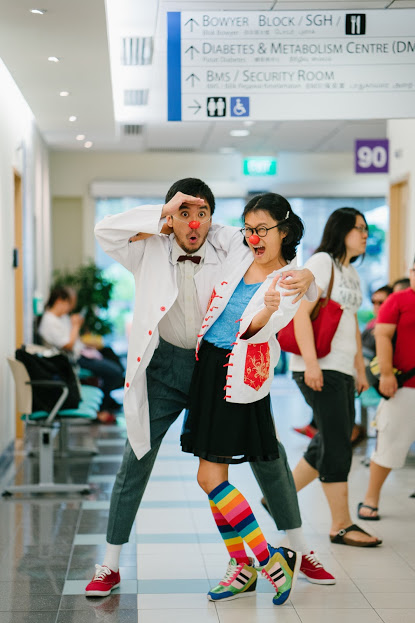
All their interactions with patients are meant to complement a patient’s recovery programme. It isn’t interaction for the sake of helping someone to pass the time. One child who was recovering from burns, for instance, was supposed to exercise her hands by opening and closing them. In response, medical clowns got her to catch 10 bubbles that they blew.
The idea, on one hand, is to use gestures to find creative ways to support a patient’s therapy. Another part of it involves changing one’s perspective on death and sickness, which can be equally important for both patients and their relatives. Cynthia explains that death is still very taboo, and when a patient is ill, they don’t always want to think about laughing and having fun.
This is what makes the work of these clown doctors so special. They create light moments even as a patient is tied up with tubes, allowing them to enjoy their final moments rather than being sad or depressed. Not only do medical clowns then bridge the gap between life and death for the patient, but also help create healing moments between patients and relatives.
For medical clowns, it’s not about just taking acting expertise, inspired by legendary acts like Charlie Chaplin and the Marx brothers, and using that with patients. By first being a clown, they lower themselves to a position where they can be made fun of.
“We’re able to be on the lowest rung of the lowest low,” is how Cynthia puts it.
They are parody doctors, so whatever a patient has ever wanted or has not been able to do to a doctor, patients can then do to them. Within limits, of course. For the elderly, many of whom do nothing but sit in chairs all day, being able to laugh at or annoyingly dismiss someone in a white lab coat can be a powerful experience. And this kind of empowerment is really the only thing that matters.
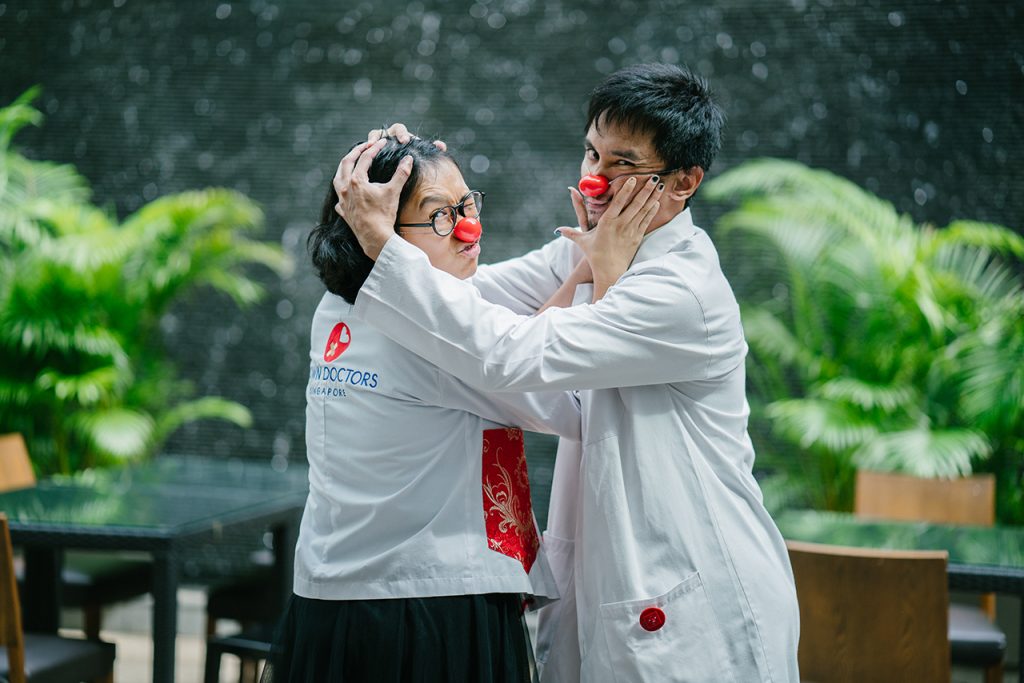
To both Cynthia and Gyan, medical clowning is a path to creating something more timeless. Gyan, for one, talks about creating a universal language. He says, “We all come from different cultures, different languages and different experiences. And my goal, with all this interaction I’m accumulating, is to find a way to use that to connect with people quicker.”
He describes how he’s noticed that in his work with patients who don’t speak the same language, everyone tends to laugh at the same things.
“Whatever language you speak,” he points out, “We all laugh at someone falling down.”
But as much as humour is central to what these medical clowns do, Cynthia hopes to eventually expand their work beyond working with children and the elderly. She talks about wanting to do relief and rescue work around the region, and how a lot more work has to be done to educate the public on the difference between Clown Doctors and other charity groups who go to clinics simply to perform for entertainment.
clown doctors need to understand how patients respond differently from typical audiences
Much like other medical professions, medical clowns undergo a rigourous training programme before they’re certified as such. They train under the Institute of Medical Clowning (IIMC) at Steinbeis University Berlin. For the medical clowns based in Singapore, it’s an intensive programme—with occasional visiting lecturers—which requires them to learn about everything from the health sciences to psychology and culture.
Over 800 hours of training is involved, and clown doctors do need to understand how patients respond differently from typical audiences. They’re required to learn how to relate to their patients, in one instance wearing weights on their bodies and ankles to understand what it’s like to experience difficulties in moving.
It’s a constant learning process. With patients who aren’t always in the best of moods, rejection doesn’t always mean rejection. Medical clowns need to learn to discern the difference, and learn how to turn these difficulties into something valuable.
“My background is in theatre, so it’s been a tougher journey for me,” Cynthia says. Pointing to Gyan, she jokes, “Not all of us are natural clowns like this guy.”
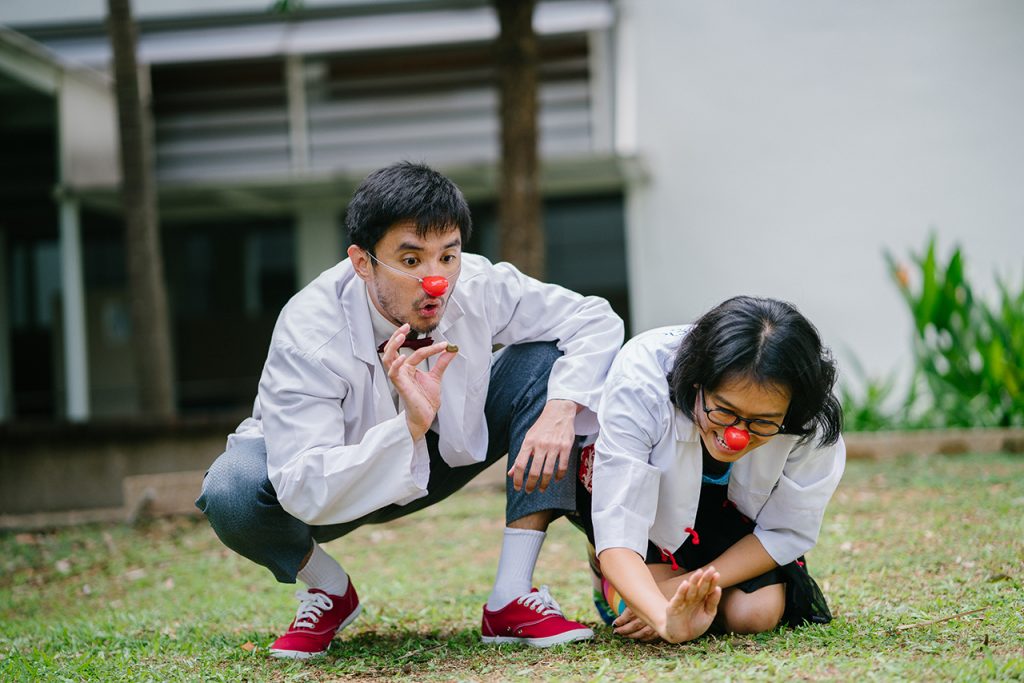
What makes Clown Doctors stand out is also the fact that all medical clowns get an allowance from the organisation. Professor Thomas Petschner, Founder & CEO of Clown Doctors Singapore, New Zealand and Asia-Pacific, pointed out that, “Financial remuneration reflects the simple belief that our team provide high quality work, which has to be seen and treated as any other occupation.”
“It’s common sense that everyone gets paid for their work and it’s always surprising to see that some people expect professional medical clowns to work for free,” he continues, “We bring fun & happiness into an environment which deals with pain, stress and problems of the sick people. Providing a small compensation is a bare minimum which our organisation can do for such a dedicated team.”
While many continue to operate under the impression that charity organisations should distance themselves from money. Professor Thomas’ approach is, in many ways, more sustainable. It allows willing volunteers our clown doctors who might otherwise pursue other lines of work (for practical reasons) to focus on working as medical clowns.
So if anyone asks—yes, medical clowning is a profession. After all, some do say that laughter is the best medicine.



